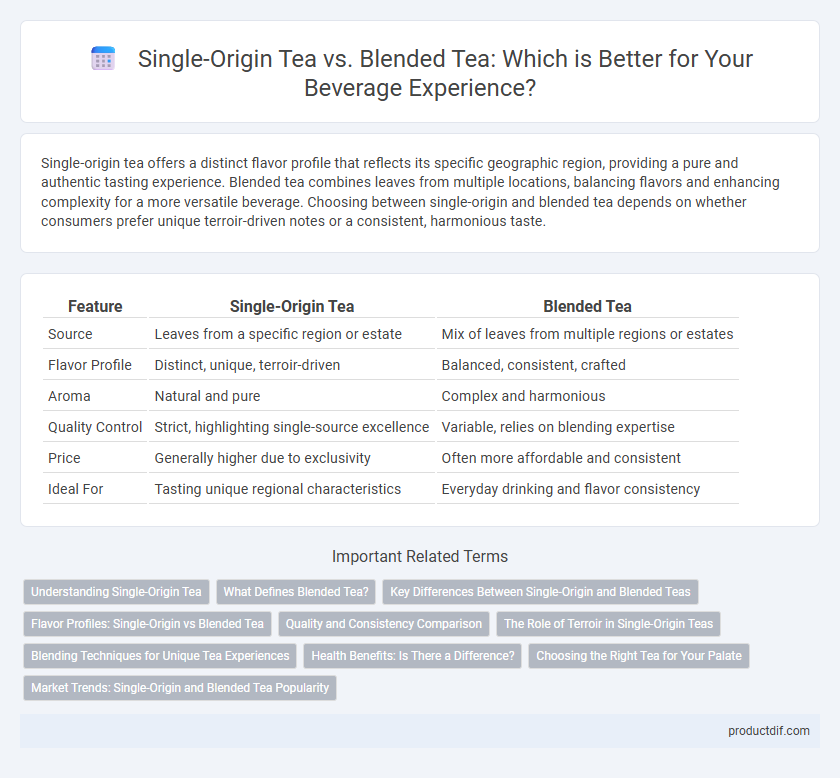Single-origin tea offers a distinct flavor profile that reflects its specific geographic region, providing a pure and authentic tasting experience. Blended tea combines leaves from multiple locations, balancing flavors and enhancing complexity for a more versatile beverage. Choosing between single-origin and blended tea depends on whether consumers prefer unique terroir-driven notes or a consistent, harmonious taste.
Table of Comparison
| Feature | Single-Origin Tea | Blended Tea |
|---|---|---|
| Source | Leaves from a specific region or estate | Mix of leaves from multiple regions or estates |
| Flavor Profile | Distinct, unique, terroir-driven | Balanced, consistent, crafted |
| Aroma | Natural and pure | Complex and harmonious |
| Quality Control | Strict, highlighting single-source excellence | Variable, relies on blending expertise |
| Price | Generally higher due to exclusivity | Often more affordable and consistent |
| Ideal For | Tasting unique regional characteristics | Everyday drinking and flavor consistency |
Understanding Single-Origin Tea
Single-origin tea is harvested from a specific geographic location, capturing unique terroir characteristics that influence flavor, aroma, and quality. These teas offer a pure, unblended taste profile that reflects the distinct climate, soil, and cultivation methods of their origin. Connoisseurs value single-origin tea for its transparency and ability to highlight regional nuances not found in blended assortments.
What Defines Blended Tea?
Blended tea is defined by the combination of leaves sourced from different regions or varieties, creating a unique flavor profile that balances aroma, taste, and strength. Unlike single-origin tea, which highlights the distinct characteristics of one specific terroir, blended teas are crafted to achieve consistency and complexity year-round. The expert blending process enhances subtle notes and can include additional ingredients like herbs or spices to enrich the sensory experience.
Key Differences Between Single-Origin and Blended Teas
Single-origin tea is sourced from a specific region or estate, highlighting unique flavor profiles and terroir characteristics, while blended tea combines leaves from multiple origins to create balanced and consistent taste. Single-origin teas offer distinctive aromas and nuanced complexity reflective of their birthplace, appealing to connoisseurs seeking authenticity. Blended teas prioritize uniform flavor and aroma, often crafted to achieve a harmonious and versatile beverage suitable for broader consumer preferences.
Flavor Profiles: Single-Origin vs Blended Tea
Single-origin tea offers distinct flavor profiles that reflect the unique terroir of a specific region, often showcasing delicate, nuanced notes such as floral, fruity, or earthy characteristics. Blended tea combines leaves from multiple origins to create a balanced, consistent taste, often enhancing complexity with harmonious layers of sweetness, spice, or malt. The choice between single-origin and blended tea depends on personal preference for either pure, region-specific flavors or a tailored, multi-dimensional cup.
Quality and Consistency Comparison
Single-origin tea offers unique flavor profiles and higher quality due to its cultivation in a specific geographic region with distinct soil and climate conditions. Blended tea provides consistent taste and aroma by combining multiple tea leaves from different sources, ensuring uniformity in each batch. Quality in single-origin tea varies with harvests and terroir, while blended tea guarantees stability for consumer expectations.
The Role of Terroir in Single-Origin Teas
Single-origin teas showcase unique flavor profiles directly influenced by the terroir, which includes the soil composition, climate, and altitude of the specific growing region. These environmental factors impart distinct aromatic and taste characteristics, making each single-origin tea a true reflection of its geographic origin. In contrast, blended teas combine leaves from multiple regions to create consistent and balanced flavor profiles, often sacrificing the nuanced complexity found in single-origin varieties.
Blending Techniques for Unique Tea Experiences
Blending techniques for tea involve combining leaves from different regions, harvests, or varieties to create unique flavor profiles that single-origin teas cannot offer. By carefully selecting complementary teas, blenders balance aroma, taste, and mouthfeel to craft complex and consistent beverages that appeal to diverse palates. This process enhances tea complexity, allowing innovative flavors such as floral, fruity, or spicy notes to emerge, enriching the overall tea experience.
Health Benefits: Is There a Difference?
Single-origin tea offers distinct antioxidant profiles and higher polyphenol concentrations compared to blended tea, contributing to enhanced health benefits such as improved cardiovascular function and reduced inflammation. Blended teas combine leaves from multiple sources, potentially diluting these benefits but offering a balanced flavor and diverse nutrient spectrum. Research indicates single-origin teas may provide more potent bioactive compounds, though blended teas still support hydration and moderate antioxidant intake.
Choosing the Right Tea for Your Palate
Single-origin tea offers a distinct flavor profile that reflects the unique terroir of its specific region, ideal for those who appreciate nuanced and authentic tastes. Blended tea combines leaves from different origins to create balanced, consistent flavors, suited for drinkers seeking complexity and smoothness. Understanding your palate's preference for either bold singular notes or harmonious blends aids in selecting the perfect tea experience.
Market Trends: Single-Origin and Blended Tea Popularity
Single-origin tea is gaining traction in the market due to consumer demand for authentic, traceable flavors and sustainable sourcing. Blended tea remains popular for its consistent taste profiles and versatility in creating unique flavor combinations. Market trends indicate a growing niche for premium single-origin varieties alongside steady growth in the blended tea segment driven by innovation and consumer preference for diverse options.
Single-Origin Tea vs Blended Tea Infographic

 productdif.com
productdif.com